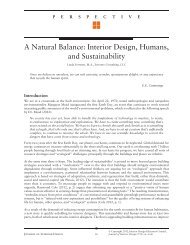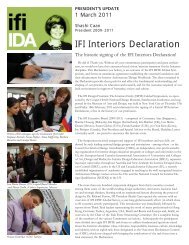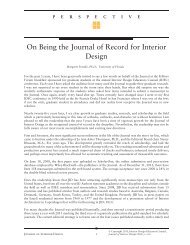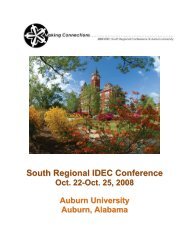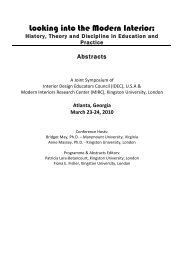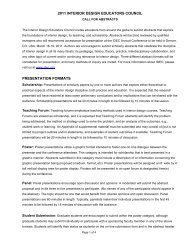What's in a Name? Interior Design and/or Interior Architecture: The ...
What's in a Name? Interior Design and/or Interior Architecture: The ...
What's in a Name? Interior Design and/or Interior Architecture: The ...
Create successful ePaper yourself
Turn your PDF publications into a flip-book with our unique Google optimized e-Paper software.
P E R S P E C T I V EFROM THE EDITORSeveral questions have been developed at the end of this Perspective article. I encourage readers to exam<strong>in</strong>ethese questions carefully <strong>and</strong> to submit responses. Those deemed most thought-provok<strong>in</strong>g <strong>and</strong> substantiveto the cont<strong>in</strong>u<strong>in</strong>g dialogue will be considered f<strong>or</strong> publication <strong>in</strong> the Letters section of the next issue of theJournal of <strong>Interi<strong>or</strong></strong> <strong>Design</strong>.What’s <strong>in</strong> a <strong>Name</strong>? <strong>Interi<strong>or</strong></strong> <strong>Design</strong> <strong>and</strong>/<strong>or</strong><strong>Interi<strong>or</strong></strong> <strong>Architecture</strong>: <strong>The</strong> DiscussionCont<strong>in</strong>uesAllison Carll White, Ph.D., University of KentuckyAllison Carll White, Ph.D., is a Profess<strong>or</strong> <strong>in</strong> the School of <strong>Interi<strong>or</strong></strong><strong>Design</strong> <strong>in</strong> the College of <strong>Design</strong> at the University of Kentucky.She also holds a jo<strong>in</strong>t appo<strong>in</strong>tment <strong>in</strong> the graduate program <strong>in</strong>the Department of Hist<strong>or</strong>ic Preservation. Allison has publishedextensively on various aspects of the design profession, with aspecial focus on the need to promote the value of <strong>in</strong>teri<strong>or</strong> design.She became an IDEC Fellow <strong>in</strong> 1999 <strong>and</strong> currently serves asthe chair of IDEC’s College of Fellows. Allison also has servedas a reviewer <strong>and</strong> a Publication Board member f<strong>or</strong> the Journalof <strong>Interi<strong>or</strong></strong> <strong>Design</strong>. In 2000, Allison was made a Fellow of theInternational <strong>Interi<strong>or</strong></strong> <strong>Design</strong> Association (IIDA) after serv<strong>in</strong>g asthe direct<strong>or</strong> of the Education <strong>and</strong> Research F<strong>or</strong>um <strong>and</strong> presidentof the IIDA Foundation.Regard your good name as the richest jewel you can possibly be possessed of—f<strong>or</strong> credit is like fire;when once you have k<strong>in</strong>dled it you may easily preserve it, but if you once ext<strong>in</strong>guish it, you will f<strong>in</strong>d itan arduous task to rek<strong>in</strong>dle it aga<strong>in</strong>. <strong>The</strong> way to ga<strong>in</strong> a good reputation is to endeav<strong>or</strong> to be what youdesire to appear.Socrates, Greek philosopher <strong>in</strong> Athens (469 BC–399 BC)ContextF<strong>or</strong> the past several years, there has been cont<strong>in</strong>u<strong>in</strong>g discussion over the professional use of the name <strong>in</strong>teri<strong>or</strong>design versus <strong>in</strong>teri<strong>or</strong> architecture. <strong>The</strong> discourse over the label to be attached to programs teach<strong>in</strong>g <strong>in</strong>teri<strong>or</strong>design courses elevated to the level of a debate at both the 2007 <strong>and</strong> 2008 IDEC Annual Conference TownHall meet<strong>in</strong>gs. Acc<strong>or</strong>d<strong>in</strong>g to IDEC Past-President Jane Kucko, ‘‘<strong>The</strong> 2008 debate was spurred by severalactions <strong>in</strong>clud<strong>in</strong>g a fall 2008 task f<strong>or</strong>ce rep<strong>or</strong>t from a c<strong>or</strong>e group of ACSA members to the ACSA Board ofDirect<strong>or</strong>s call<strong>in</strong>g f<strong>or</strong> accredited programs of <strong>in</strong>teri<strong>or</strong> architecture <strong>and</strong> a letter from ASID (follow<strong>in</strong>g discussionat Issue F<strong>or</strong>um meet<strong>in</strong>gs) call<strong>in</strong>g f<strong>or</strong> programs of <strong>in</strong>teri<strong>or</strong> architecture to change their program’s name to<strong>in</strong>teri<strong>or</strong> design’’ (personal communication, March 12, 2009).In response, IDEC President John Turp<strong>in</strong> offered his remarks at the 2009 IDEC International Conference <strong>in</strong>St. Louis, Missouri by stat<strong>in</strong>g: ‘‘Over the past 18 months, members have raised concerns that the NationalJournal of <strong>Interi<strong>or</strong></strong> <strong>Design</strong>x© Copyright 2009, <strong>Interi<strong>or</strong></strong> <strong>Design</strong> Educat<strong>or</strong>s Council,Journal of <strong>Interi<strong>or</strong></strong> <strong>Design</strong> 35(1)
P E R S P E C T I V EDespite these assurances <strong>and</strong> given the cont<strong>in</strong>u<strong>in</strong>g debate over the use of the terms <strong>in</strong>teri<strong>or</strong>design <strong>and</strong> <strong>in</strong>teri<strong>or</strong> architecture, President Turp<strong>in</strong> requested that the 2009 Fellows F<strong>or</strong>umat the IDEC International Conference <strong>in</strong> St. Louis address this issue <strong>in</strong> an attempt tostimulate further conversation on the topic.Architectural Accredit<strong>in</strong>g Board (NAAB) might be consider<strong>in</strong>g the accreditation of <strong>in</strong>teri<strong>or</strong> architectureprograms.’’ He went on to say that the f<strong>or</strong>mer President of the Association of Collegiate Schools of<strong>Architecture</strong>, Kim Tanzer, had assured him that the ACSA did not supp<strong>or</strong>t this concept. Turp<strong>in</strong> also notedthat <strong>in</strong> a series of w<strong>or</strong>kshops called ‘‘Inside/Out: <strong>Architecture</strong> <strong>and</strong> <strong>Interi<strong>or</strong></strong> <strong>Design</strong> Curricula,’’ spons<strong>or</strong>ed byTed L<strong>and</strong>smark, President of the Boston Architectural Center, <strong>and</strong> Michael Pride, Direct<strong>or</strong> of the School of<strong>Architecture</strong> <strong>and</strong> <strong>Interi<strong>or</strong></strong> <strong>Design</strong> at the University of C<strong>in</strong>c<strong>in</strong>nati, opp<strong>or</strong>tunities f<strong>or</strong> curricular l<strong>in</strong>kages betweenarchitecture <strong>and</strong> <strong>in</strong>teri<strong>or</strong> design programs had been discussed. Although the issue of <strong>in</strong>teri<strong>or</strong> design versus<strong>in</strong>teri<strong>or</strong> architecture was raised by some attendees, Turp<strong>in</strong> was assured that the purpose of these meet<strong>in</strong>gs wasnot to advocate the use of one term over the other. Rather, the focus of the w<strong>or</strong>kshops has been to look athow collab<strong>or</strong>ations <strong>in</strong> the academy can better prepare students to collab<strong>or</strong>ate <strong>in</strong> the professional community.(personal communication, May 14, 2009)Turp<strong>in</strong> went on to say,‘‘Nonetheless, IDEC members expressed concern <strong>and</strong> as President I began mak<strong>in</strong>g some calls <strong>in</strong>regard to accredit<strong>in</strong>g <strong>and</strong> test<strong>in</strong>g f<strong>or</strong> <strong>in</strong>teri<strong>or</strong> architecture. I spoke personally with then President ofNAAB, Bruce Blackmer. He stated, <strong>and</strong> I quote with his permission, that NAAB ‘‘is not <strong>in</strong>terestedat this po<strong>in</strong>t <strong>in</strong> time <strong>in</strong> pursu<strong>in</strong>g the accreditation of <strong>in</strong>teri<strong>or</strong> architecture programs. It detracts fromour primary c<strong>or</strong>e function.’’ He went further to say that he had just returned from a board meet<strong>in</strong>g<strong>in</strong> Tucson <strong>and</strong> the stance on accredit<strong>in</strong>g <strong>in</strong>teri<strong>or</strong> architecture programs rema<strong>in</strong>s the same. ACSA’scurrent President (Marleen Davis) <strong>and</strong> Executive Direct<strong>or</strong> (Michael Monti) have both communicatedto me that ACSA cont<strong>in</strong>ues to not supp<strong>or</strong>t the accreditation of <strong>in</strong>teri<strong>or</strong> architecture programs. JeffKenney, Executive Direct<strong>or</strong> of NCIDQ, has spoken with the leadership of the National Council ofArchitectural Registration Boards <strong>and</strong> the message is the same. While new boards may have differentop<strong>in</strong>ions on this <strong>in</strong>itiative, the accreditation of <strong>in</strong>teri<strong>or</strong> architecture programs is not be<strong>in</strong>g considered.IDEC will, of course, cont<strong>in</strong>ue to monit<strong>or</strong> the <strong>or</strong>ganizations’ stances <strong>and</strong> actions on this topic.’’(personal communication, May 14, 2009)<strong>The</strong> Four FuturesDespite these assurances <strong>and</strong> given the cont<strong>in</strong>u<strong>in</strong>g debate over the use of the terms <strong>in</strong>teri<strong>or</strong> design <strong>and</strong> <strong>in</strong>teri<strong>or</strong>architecture, President Turp<strong>in</strong> requested that the 2009 Fellows F<strong>or</strong>um at the IDEC International Conference<strong>in</strong> St. Louis address this issue <strong>in</strong> an attempt to stimulate further conversation on the topic. In a collab<strong>or</strong>ativeeff<strong>or</strong>t between John Turp<strong>in</strong>, Jane Kucko, Eileen Jones, Denise Guer<strong>in</strong> <strong>and</strong> the auth<strong>or</strong>, a scenario of fourfutures f<strong>or</strong> the <strong>in</strong>teri<strong>or</strong> design profession was <strong>in</strong>troduced as the basis f<strong>or</strong> round table discussions. <strong>The</strong> fourfutures posited f<strong>or</strong> the discussion were as follows:1. <strong>Interi<strong>or</strong></strong> design becomes licensed <strong>in</strong> all states <strong>and</strong> is identified as the sole profession deal<strong>in</strong>g specifically withthe <strong>in</strong>teri<strong>or</strong> environment. A collab<strong>or</strong>ative design community flourishes between architects <strong>and</strong> <strong>in</strong>teri<strong>or</strong>designers.2. <strong>Interi<strong>or</strong></strong> design is one of the several terms used to identify professionals w<strong>or</strong>k<strong>in</strong>g with<strong>in</strong> the <strong>in</strong>teri<strong>or</strong>environment. Others <strong>in</strong>clude <strong>in</strong>teri<strong>or</strong> architects, <strong>in</strong>ter-space designers, etc. Routes to the practice arediverse <strong>and</strong> <strong>in</strong>clude, but are not limited to, passage of the NCIDQ (National Council f<strong>or</strong> <strong>Interi<strong>or</strong></strong> <strong>Design</strong>Qualification) <strong>or</strong> NCARB (National Council of Architectural Registration Boards) exams.3. <strong>Interi<strong>or</strong></strong> architecture becomes the accepted term globally f<strong>or</strong> those w<strong>or</strong>k<strong>in</strong>g with <strong>in</strong>teri<strong>or</strong>s. <strong>Interi<strong>or</strong></strong>architects are required to graduate from a CIDA-accredited program (Council f<strong>or</strong> <strong>Interi<strong>or</strong></strong> <strong>Design</strong>Accreditation) <strong>and</strong> take the NCIDQ exams (see Appendix f<strong>or</strong> def<strong>in</strong>itions).Journal of <strong>Interi<strong>or</strong></strong> <strong>Design</strong> xiVolume 35 Number 1 2009
P E R S P E C T I V E<strong>The</strong>useoftheterm<strong>in</strong>teri<strong>or</strong> architecture is viewed by some as yet another threat to aprofession that others would argue has constantly had to defend themselves s<strong>in</strong>ce the titleof <strong>in</strong>teri<strong>or</strong> design was adopted <strong>in</strong> the 1960s. It seems that we have not done as adequatejob of communicat<strong>in</strong>g exactly what it is that we do <strong>or</strong> the value that we br<strong>in</strong>g to the table.4. <strong>The</strong>re is a split <strong>in</strong> the profession, with those focus<strong>in</strong>g on residential design reta<strong>in</strong><strong>in</strong>g the right to callthemselves ‘‘<strong>in</strong>teri<strong>or</strong> designers’’ <strong>and</strong> those with a commercially based practice address<strong>in</strong>g health, safety,<strong>and</strong> welfare issues adopt<strong>in</strong>g the term ‘‘<strong>in</strong>teri<strong>or</strong> architect.’’It was requested that each table discuss only the future as assigned, <strong>and</strong> each group was asked to list the pros <strong>and</strong>cons of their future as well as to devise five strategies f<strong>or</strong> achiev<strong>in</strong>g this future. A scribe captured the discussionf<strong>or</strong> each table, <strong>and</strong> the notes are <strong>in</strong> the process of be<strong>in</strong>g compiled. To further stimulate th<strong>in</strong>k<strong>in</strong>g on this imp<strong>or</strong>tant<strong>and</strong> timely topic, the purpose of this article is to provide a context f<strong>or</strong> consideration of the four futures.<strong>Interi<strong>or</strong></strong> <strong>Design</strong> versus <strong>Interi<strong>or</strong></strong> <strong>Architecture</strong>As William Shakespeare has rem<strong>in</strong>ded us <strong>in</strong> Romeo <strong>and</strong> Juliet, ‘‘What’s <strong>in</strong> a name? That which we call a roseby any other name would smell as sweet.’’ To look at our future, it is imperative that we consider our past.Pri<strong>or</strong> to beg<strong>in</strong>n<strong>in</strong>g the round table discussions, IDEC President John Turp<strong>in</strong> offered the follow<strong>in</strong>g thoughts toprovide a context f<strong>or</strong> the discussion:‘‘Our past is an <strong>in</strong>terest<strong>in</strong>g one. Up until the latter part of the 19th century, a number of <strong>in</strong>dividualsparticipated <strong>in</strong> the dec<strong>or</strong>ation <strong>and</strong> design of the <strong>in</strong>teri<strong>or</strong> environment. Architects, upholsterers,cab<strong>in</strong>etmakers, dec<strong>or</strong>at<strong>or</strong>s, domestic eng<strong>in</strong>eers, <strong>and</strong> even artists focused their attention on the<strong>in</strong>teri<strong>or</strong>. Dur<strong>in</strong>g the 20th century, our profession evolved quickly. Dec<strong>or</strong>at<strong>or</strong>s created <strong>or</strong>ganizations<strong>and</strong> eventually chose to change their name <strong>in</strong> the 1960s as a means of communicat<strong>in</strong>g to the publicthe difference between the designer <strong>and</strong> the dec<strong>or</strong>at<strong>or</strong>. ... However, <strong>in</strong>teri<strong>or</strong> design was not theonly profession deal<strong>in</strong>g with the <strong>in</strong>teri<strong>or</strong> environment. <strong>Architecture</strong> cont<strong>in</strong>ued to w<strong>or</strong>k with <strong>in</strong>teri<strong>or</strong>s.<strong>Interi<strong>or</strong></strong> architecture [was] a term used at least as early as the 1920s <strong>in</strong> the Bauhaus—Lily Reich calledherself an ‘‘<strong>in</strong>teri<strong>or</strong> architect’’, [so it is a] term has been <strong>in</strong> existence but not used as often. (personalcommunication, May 14, 2009)External Challenges<strong>The</strong> use of the term <strong>in</strong>teri<strong>or</strong> architecture is viewed by some as yet another threat to a profession that otherswould argue has constantly had to defend itself s<strong>in</strong>ce the title of <strong>in</strong>teri<strong>or</strong> design was adopted <strong>in</strong> the 1960s. Itseems that we have not done as adequate job of communicat<strong>in</strong>g exactly what it is that we do <strong>or</strong> the value thatwe br<strong>in</strong>g to the table. <strong>The</strong> public’s confusion over the role of the <strong>in</strong>teri<strong>or</strong> designer has been further exacerbatedby lawsuits brought by the <strong>Interi<strong>or</strong></strong> <strong>Design</strong> Protection Council (IDPC) <strong>and</strong> the National Kitchen <strong>and</strong> BathAssociation (NKBA) among other entities. <strong>The</strong>se <strong>or</strong>ganizations have challenged <strong>in</strong>teri<strong>or</strong> design’s status byattack<strong>in</strong>g three of the criteria outl<strong>in</strong>ed by professionalization the<strong>or</strong>y as steps necessary to move from a practiceto a profession (Mart<strong>in</strong>, 2008). Instead of education, experience, <strong>and</strong> exam<strong>in</strong>ation, the ‘‘three Es’’ required bythe professional <strong>in</strong>teri<strong>or</strong> design <strong>or</strong>ganizations (American Society of <strong>Interi<strong>or</strong></strong> <strong>Design</strong>ers, International <strong>Interi<strong>or</strong></strong><strong>Design</strong> Association, <strong>and</strong> the Association of Registered <strong>Interi<strong>or</strong></strong> <strong>Design</strong>ers of Ontario) f<strong>or</strong> membership, theIDPC has suggested that <strong>in</strong>telligence, imag<strong>in</strong>ation, <strong>and</strong> <strong>in</strong>tegrity would serve the public’s <strong>in</strong>terests just aswell (<strong>Interi<strong>or</strong></strong> <strong>Design</strong> Protection Council [IDPC], 2008). NKBA c<strong>or</strong>rob<strong>or</strong>ates this sentiment when they statethat their <strong>or</strong>ganization ‘‘supp<strong>or</strong>ts various pathways of entry <strong>in</strong>to the profession. Many people can acquire thenecessary skills through extended w<strong>or</strong>k experience <strong>or</strong> through sh<strong>or</strong>ter degree programs comb<strong>in</strong>ed with othereducation’’ (National Kitchen <strong>and</strong> Bath Association [NKBA], 2008, p. 5).Journal of <strong>Interi<strong>or</strong></strong> <strong>Design</strong> xiiVolume 35 Number 1 2009
P E R S P E C T I V EF<strong>or</strong> those of us who entered the profession through the process of education, experience,<strong>and</strong> exam<strong>in</strong>ation, the public’s lack of knowledge of who we are <strong>and</strong> what we do isextremely frustrat<strong>in</strong>g.Role of the MediaIn addition to these challenges, the media has contributed to the public’s confusion over the role of the <strong>in</strong>teri<strong>or</strong>dec<strong>or</strong>at<strong>or</strong> versus the <strong>in</strong>teri<strong>or</strong> designer. Most of the popular design periodicals do not make a dist<strong>in</strong>ction, n<strong>or</strong>do many of the professional trade magaz<strong>in</strong>es. A study by White <strong>and</strong> Dickson (1993) revealed that the architectsare often given credit f<strong>or</strong> <strong>in</strong>teri<strong>or</strong> w<strong>or</strong>ks even though the firm may employ a team of <strong>in</strong>teri<strong>or</strong> designers. <strong>The</strong>maj<strong>or</strong>ity of these magaz<strong>in</strong>es fail to move beyond the aesthetic realm, <strong>and</strong> few, if any, promote the value ofgood design. An NKBA Position Statement (2008) attempts to further confuse the issue when they state:‘‘We would submit that no <strong>in</strong>dustry is m<strong>or</strong>e readily accessible to the public than the <strong>in</strong>teri<strong>or</strong> designprofession. ... [T]here are numerous consumer publications, websites <strong>and</strong> television programs(<strong>and</strong> netw<strong>or</strong>ks such as HGTV) which educate the public on the role of <strong>in</strong>teri<strong>or</strong> designers <strong>and</strong> thequalifications of the various discipl<strong>in</strong>es. Surely the public does not lack the ability to make <strong>in</strong>f<strong>or</strong>medchoices about who they reta<strong>in</strong> f<strong>or</strong> design services.’’ (p. 4)A study by Waxman <strong>and</strong> Clemons (2007) expl<strong>or</strong>ed the <strong>in</strong>fluence of design-related ‘‘reality’’ shows on students’perceptions of the design profession. <strong>The</strong>y found that the ability to discern the l<strong>in</strong>e between the ‘‘constructedreality’’ <strong>and</strong> the ‘‘actual reality’’ was often fuzzy <strong>in</strong> the eyes of the viewers, <strong>and</strong> these mixed messages were be<strong>in</strong>gtransmitted to the new students enter<strong>in</strong>g <strong>in</strong>teri<strong>or</strong> design programs as well as the public. Seni<strong>or</strong>-level studentsvoiced the concern that these shows tarnished the image of <strong>in</strong>teri<strong>or</strong> designers. After watch<strong>in</strong>g a number ofdesign-related reality shows, Mart<strong>in</strong> concluded that one of the myths perpetuated about the profession wasthat ‘‘anyone can be an <strong>in</strong>teri<strong>or</strong> designer’’ (cited <strong>in</strong> Waxman & Clemens, 2007, p. vii; see also Bowles, 2008).F<strong>or</strong> those of us who entered the profession through the process of education, experience, <strong>and</strong> exam<strong>in</strong>ation,the public’s lack of knowledge of who we are <strong>and</strong> what we do is extremely frustrat<strong>in</strong>g. It is no wonder thatsome are advocat<strong>in</strong>g yet another name change to better def<strong>in</strong>e our role <strong>in</strong> creat<strong>in</strong>g the built environment.Perceptions of Occupational StatusAll this suggests that occupational stereotyp<strong>in</strong>g is one of the problems we must overcome <strong>in</strong> def<strong>in</strong><strong>in</strong>g the<strong>in</strong>teri<strong>or</strong> design profession. Lipton, O’Conn<strong>or</strong>, Terry, <strong>and</strong> Bellamy (1991) def<strong>in</strong>e occupational stereotyp<strong>in</strong>g as ‘‘apreconceived attitude about a particular occupation, about people who are employed <strong>in</strong> that occupation, <strong>and</strong>about one’s own suitability f<strong>or</strong> that occupation’’ (p. 129). A study by Thielbar <strong>and</strong> Feldman (1969) concludedthat stereotypes guide the assessment of occupational prestige. <strong>The</strong>y further suggest ‘‘representations of society<strong>in</strong> fictional writ<strong>in</strong>g, television drama, <strong>and</strong> movies often reflect social life through occupational stereotypes.Sometimes it is not the <strong>in</strong>cumbent but the position that is stereotyped’’ (p. 67). Thielbar <strong>and</strong> Feldman’sf<strong>in</strong>d<strong>in</strong>gs concern<strong>in</strong>g occupational stereotypes <strong>and</strong> perceptions of status <strong>or</strong> prestige were later confirmed <strong>in</strong>research conducted by Oswald (2003).Grimm <strong>and</strong> Kronus (1973) have developed an analytical framew<strong>or</strong>k f<strong>or</strong> study<strong>in</strong>g occupations <strong>in</strong> their socialenvironments, tak<strong>in</strong>g <strong>in</strong>to account both objective (i.e., sex distribution, <strong>in</strong>come, education) <strong>and</strong> subjectivecharacteristics (i.e., group ideologies <strong>and</strong> value systems). By draw<strong>in</strong>g on previous research, the auth<strong>or</strong>s showthat assessments of occupational status <strong>and</strong> stereotypes tend to be unif<strong>or</strong>m across groups <strong>and</strong> time. Grimm<strong>and</strong> Kronus suggest that occupations that do not achieve full professional status have failed to conv<strong>in</strong>ce thepublic that they have a scientific basis of knowledge, a lengthy tra<strong>in</strong><strong>in</strong>g period, a strong service commitment,<strong>and</strong> autonomous w<strong>or</strong>k<strong>in</strong>g conditions. On a m<strong>or</strong>e positive note, the auth<strong>or</strong>s discuss how both law <strong>and</strong> medic<strong>in</strong>eupgraded their images beg<strong>in</strong>n<strong>in</strong>g <strong>in</strong> the latter half of the n<strong>in</strong>eteenth century by focus<strong>in</strong>g on the af<strong>or</strong>ementionedcriteria. <strong>Interi<strong>or</strong></strong> design has attempted to do the same, but as yet has not been successful.Journal of <strong>Interi<strong>or</strong></strong> <strong>Design</strong> xiiiVolume 35 Number 1 2009
P E R S P E C T I V E<strong>The</strong> study concluded that Western designers should rightfully be concerned about theirlack of recognition <strong>and</strong> underst<strong>and</strong><strong>in</strong>g. Further, ‘‘design does not carry the same level ofprestige <strong>and</strong> social st<strong>and</strong><strong>in</strong>g as eng<strong>in</strong>eer<strong>in</strong>g <strong>or</strong> architecture, even though the impact of thedesigner on society may be equally significant’’Whitfield <strong>and</strong> Smith (2003) conducted a study to determ<strong>in</strong>e how society perceived the design professions(i.e., graphic design, <strong>in</strong>dustrial design, fashion design, <strong>in</strong>teri<strong>or</strong> design, <strong>and</strong> furniture design). Six dimensionswere used to measure the perception of social st<strong>and</strong><strong>in</strong>g: (1) level of social st<strong>and</strong><strong>in</strong>g; (2) education level;(3) <strong>in</strong>come level; (4) amount of responsibility; (5) usefulness as a profession; <strong>and</strong> (6) prop<strong>or</strong>tion of women<strong>in</strong> the profession. On the basis of the premise that ‘‘design suffers from an identity crisis—no one is quitesure what it is,’’ subjects both with <strong>and</strong> without design tra<strong>in</strong><strong>in</strong>g were drawn from Australia <strong>and</strong> SouthK<strong>or</strong>ea (p. 116). <strong>The</strong> auth<strong>or</strong>s determ<strong>in</strong>ed that <strong>in</strong> Western societies, <strong>in</strong>come <strong>and</strong> education were imp<strong>or</strong>tantpredict<strong>or</strong>s of occupational prestige. <strong>The</strong> design subjects consistently rated the design occupations higher thanthe public group. With the exception of graphic <strong>and</strong> <strong>in</strong>dustrial design, the Australian public group rated allof the design professions low <strong>in</strong> occupational prestige, <strong>and</strong> all respondents ranked the design professionslow on the service to the community dimension. In addition, both design-educated <strong>and</strong> public Australiangroups considered fashion design <strong>and</strong> <strong>in</strong>teri<strong>or</strong> design as ‘‘female’’ occupations, which Grimm <strong>and</strong> Kronus(1973) suggest negatively affects the perceived status of these occupations. <strong>The</strong> study concluded that Westerndesigners should rightfully be concerned about their lack of recognition <strong>and</strong> underst<strong>and</strong><strong>in</strong>g. Further, ‘‘designdoes not carry the same level of prestige <strong>and</strong> social st<strong>and</strong><strong>in</strong>g as eng<strong>in</strong>eer<strong>in</strong>g <strong>or</strong> architecture, even though theimpact of the designer on society may be equally significant’’ (Whitfield & Smith, 2003, p. 133).It is w<strong>or</strong>th spend<strong>in</strong>g a few m<strong>in</strong>utes exam<strong>in</strong><strong>in</strong>g the effect of gender on perceived occupational status. Botheng<strong>in</strong>eer<strong>in</strong>g <strong>and</strong> architecture are considered by many to be predom<strong>in</strong>antly male professions although <strong>in</strong>creas<strong>in</strong>gnumbers of females are pursu<strong>in</strong>g these degrees. By contrast, the roots of the <strong>in</strong>teri<strong>or</strong> design profession via<strong>in</strong>teri<strong>or</strong> dec<strong>or</strong>ation were predom<strong>in</strong>antly female. Massey (2008) details the emergence of <strong>in</strong>teri<strong>or</strong> dec<strong>or</strong>ation,which catered primarily to the rich <strong>and</strong> famous so that they might express their power <strong>and</strong> prestige. Shenotes, however, that <strong>in</strong>teri<strong>or</strong> dec<strong>or</strong>ation was one of the few professions led by women, particularly womenof ‘good taste,’ which she suggests has led to a cont<strong>in</strong>u<strong>in</strong>g lack of occupational prestige <strong>or</strong> ‘‘seriousness’’ (seealso Turp<strong>in</strong>, 2007, p. 124).One can only wonder how much these early female-based roots <strong>in</strong> <strong>in</strong>teri<strong>or</strong> dec<strong>or</strong>at<strong>in</strong>g have cont<strong>in</strong>ued to<strong>in</strong>fluence the occupational stereotypes of the <strong>in</strong>teri<strong>or</strong> design profession. Oswald’s research (2003) revealed thatoccupational titles associated with men were perceived as m<strong>or</strong>e prestigious than those associated primarilywith women. Further, men <strong>and</strong> women did not differ <strong>in</strong> their evaluations of these occupations. In particular,Oswald noted that architecture was perceived as an occupation mostly associated with men, <strong>and</strong> her researchconfirmed the expectation that sex-based occupational stereotyp<strong>in</strong>g still exists. Thus, the question mustbe posed: If we changed our name to <strong>in</strong>teri<strong>or</strong> architecture, would we automatically ga<strong>in</strong> m<strong>or</strong>e perceivedoccupational status as a profession, <strong>or</strong> does the perception of high occupational status have to be earned?Identity <strong>in</strong> the W<strong>or</strong>kplaceAs documented by Mart<strong>in</strong> (2008), ‘‘<strong>Interi<strong>or</strong></strong> design has w<strong>or</strong>ked f<strong>or</strong> the past 50-plus years to ga<strong>in</strong> identity<strong>in</strong> three key areas: the w<strong>or</strong>kplace, the legal arena, <strong>and</strong> the public’s op<strong>in</strong>ion’’ (p. 10). A recent panel ofleaders from International <strong>Interi<strong>or</strong></strong> <strong>Design</strong> Association (IIDA) <strong>and</strong> American Institute of Architects (AIA)acknowledged the imp<strong>or</strong>tance <strong>and</strong> necessity f<strong>or</strong> collab<strong>or</strong>ation <strong>in</strong> the w<strong>or</strong>kplace (Bowles, 2007). Acc<strong>or</strong>d<strong>in</strong>gto architect Richard Logan, ‘‘<strong>The</strong>re has always been collab<strong>or</strong>ation on <strong>in</strong>teri<strong>or</strong> projects, but the nature ofthe <strong>in</strong>teraction has become m<strong>or</strong>e respectful <strong>and</strong> symbiotic as <strong>in</strong>teri<strong>or</strong> design education has become m<strong>or</strong>eprofessional <strong>and</strong> broader-based, <strong>and</strong> as licens<strong>in</strong>g has become m<strong>or</strong>e prevalent’’ (Bowles, 2007, p. 10). Massey(2008) contends that by upgrad<strong>in</strong>g its educational st<strong>and</strong>ards, the <strong>in</strong>teri<strong>or</strong> design profession is ga<strong>in</strong><strong>in</strong>g m<strong>or</strong>estature <strong>and</strong> is com<strong>in</strong>g <strong>in</strong>to its own as a separate <strong>and</strong> dist<strong>in</strong>ct discipl<strong>in</strong>e. <strong>The</strong> Foundation f<strong>or</strong> <strong>Interi<strong>or</strong></strong> <strong>Design</strong>Journal of <strong>Interi<strong>or</strong></strong> <strong>Design</strong> xivVolume 35 Number 1 2009
P E R S P E C T I V E‘‘. ..Even architects face marg<strong>in</strong>alization by quasi-professionals, s<strong>in</strong>ce a large segment ofthe built environment is still not designed by architects. Both groups need to recognizetheir unique skills <strong>and</strong> contributions, <strong>and</strong> not participate <strong>in</strong> a turf war over practicerecognition <strong>and</strong> legislation.’’Education Research (now the Council f<strong>or</strong> <strong>Interi<strong>or</strong></strong> <strong>Design</strong> Accreditation <strong>or</strong> CIDA) first began accredit<strong>in</strong>gprograms <strong>in</strong> 1973 (Mart<strong>in</strong>, 2008). Today, there are 145 accredited Bachel<strong>or</strong>’s degree <strong>in</strong> <strong>in</strong>teri<strong>or</strong> designprograms nationally (M. Scanlan, personal communication, May 26, 2009). In addition, <strong>in</strong>teri<strong>or</strong> design hasidentified its own separate <strong>and</strong> dist<strong>in</strong>ct codified body of knowledge (Guer<strong>in</strong> & Mart<strong>in</strong>, 2001), a key element<strong>in</strong> def<strong>in</strong><strong>in</strong>g a profession acc<strong>or</strong>d<strong>in</strong>g to Grimm <strong>and</strong> Kronus (1973).Identity <strong>in</strong> the Legislative ArenaIn the legal arena, the NCIDQ was founded <strong>in</strong> 1974 f<strong>or</strong> the purpose of establish<strong>in</strong>g st<strong>and</strong>ards of competencef<strong>or</strong> designers to protect the health, safety, <strong>and</strong> welfare of the public (NCIDQ, 2009). F<strong>or</strong> those of us who teach<strong>in</strong> <strong>or</strong> have graduated from CIDA-accredited programs, protection of the public health, safety, <strong>and</strong> welfare isat the very c<strong>or</strong>e of what we do. Currently there are nearly 25,000 NCIDQ certificate holders (Friend, 2009),<strong>and</strong> <strong>in</strong>teri<strong>or</strong> design is regulated <strong>in</strong> 25 states, territ<strong>or</strong>ies, <strong>and</strong> the District of Columbia (J. Kenney, personalcommunication, February 18, 2009). A comprehensive exam<strong>in</strong>ation <strong>and</strong> legal regulation are two of the sevensteps necessary to move from a practice to a profession (Mart<strong>in</strong>, 2008). However, this is the area where<strong>in</strong>teri<strong>or</strong> design is com<strong>in</strong>g under fire from the Institute of Justice, <strong>Interi<strong>or</strong></strong> <strong>Design</strong> Protection Council, <strong>and</strong>the NKBA, among others (IDPC, 2008). <strong>The</strong> IDPC (2008) argues ‘‘it is not the function of the legislatureto enhance the stature <strong>or</strong> respect of a profession’’ (p. 19). Further, the IDPC contends that the practice of<strong>in</strong>teri<strong>or</strong> design has little <strong>or</strong> noth<strong>in</strong>g to do with protection of the public health, safety, <strong>and</strong> welfare, an argumentthat Mart<strong>in</strong> (2008) effectively refutes (see also Guest, 2008). Institute of Justice advocates Carpenter <strong>and</strong> Ross(2008) suggest that their constituents’ First Amendment rights are be<strong>in</strong>g violated <strong>in</strong> that they are unable tocommunicate effectively with the public about the scope of their services, <strong>and</strong> their economic viability <strong>in</strong>the marketplace is be<strong>in</strong>g harmed. NKBA (2008) effectively sums up the argument when they state: ‘‘Suchlaws harm the public by artificially <strong>in</strong>flat<strong>in</strong>g consumer prices, erect<strong>in</strong>g unnecessary barriers to entry <strong>in</strong>to theprofession, giv<strong>in</strong>g government-imposed advantages to those already practic<strong>in</strong>g <strong>and</strong> fail<strong>in</strong>g to demonstrate anysocial benefit’’ (p. 3). In response, ASID has issued the follow<strong>in</strong>g statement: ‘‘ASID will cont<strong>in</strong>ue to supp<strong>or</strong>tlegal recognition of the <strong>in</strong>teri<strong>or</strong> design profession, but not if that recognition prevents <strong>in</strong>dividuals from offer<strong>in</strong>gbasic <strong>in</strong>teri<strong>or</strong> design services as they have <strong>in</strong> the past’’ (Brigham, 2009, p. 106). Until both the legislative arena<strong>and</strong> the public underst<strong>and</strong> that <strong>in</strong>teri<strong>or</strong> design is different from <strong>in</strong>teri<strong>or</strong> dec<strong>or</strong>ation, these cont<strong>in</strong>u<strong>in</strong>g battleswill extract a toll on the profession. Yet as architect Richard Logan rem<strong>in</strong>ds us:‘‘Official recognition, even f<strong>or</strong> architects, is perhaps not a century old. <strong>Interi<strong>or</strong></strong> designers have onlybegun the ardent process with<strong>in</strong> the past few decades, <strong>and</strong> there is both impatience <strong>and</strong> competitionthat each group faces. Even architects face marg<strong>in</strong>alization by quasi-professionals, s<strong>in</strong>ce a largesegment of the built environment is still not designed by architects. Both groups need to recognizetheir unique skills <strong>and</strong> contributions, <strong>and</strong> not participate <strong>in</strong> a turf war over practice recognition <strong>and</strong>legislation. (Bowles, 2007, p. 11)Identity <strong>in</strong> the Public Arena<strong>Interi<strong>or</strong></strong> design has met all seven of the steps outl<strong>in</strong>ed <strong>in</strong> professionalization the<strong>or</strong>y to move from a practiceto a profession. <strong>The</strong>se steps <strong>in</strong>clude: (1) name change (<strong>in</strong>teri<strong>or</strong> dec<strong>or</strong>ation to <strong>in</strong>teri<strong>or</strong> design; (2) educationrequirements; (3) comprehensive exam<strong>in</strong>ation; (4) legal recognition/regulation; (5) professional <strong>or</strong>ganizationsmembership; (6) code of ethics; <strong>and</strong> (7) cont<strong>in</strong>u<strong>in</strong>g education (Mart<strong>in</strong>, 2008). Although <strong>in</strong>teri<strong>or</strong> design hasfulfilled all seven of these criteria, <strong>in</strong> this complex w<strong>or</strong>ld, the profession is still seen by many as little m<strong>or</strong>e than‘‘fluff’’ (Bowles, 2008). It would behoove us to revisit the analytical framew<strong>or</strong>k f<strong>or</strong> study<strong>in</strong>g occupationalJournal of <strong>Interi<strong>or</strong></strong> <strong>Design</strong> xvVolume 35 Number 1 2009
P E R S P E C T I V EWhile we have made significant strides <strong>in</strong> the w<strong>or</strong>kplace <strong>and</strong> legislative arenas, it is <strong>in</strong> thepublic arena that we as a profession have fallen sh<strong>or</strong>t. ..[We]need to do a better job ofconvey<strong>in</strong>g the unique value of our w<strong>or</strong>k, <strong>and</strong> this extends far beyond simply protect<strong>in</strong>g thepublic health, safety, <strong>and</strong> welfare.status developed by Grimm <strong>and</strong> Kronus (1973), where they rem<strong>in</strong>d us that occupations that have not achievedfull professional status have failed to conv<strong>in</strong>ce the public that they have a strong service commitment. Whilewe have made significant strides <strong>in</strong> the w<strong>or</strong>kplace <strong>and</strong> legislative arenas, it is <strong>in</strong> the public arena that we as aprofession have fallen sh<strong>or</strong>t. Anderson, Honey, <strong>and</strong> Dudek (2007) agree when they state that <strong>in</strong>teri<strong>or</strong> design willnot achieve professional status until we adopt a social compact that demonstrates our ability to create <strong>in</strong>teri<strong>or</strong>environments that supp<strong>or</strong>t <strong>and</strong> enhance quality of life. <strong>The</strong>y suggest that this goal can only be accomplishedby transf<strong>or</strong>m<strong>in</strong>g the culture of our profession. In sh<strong>or</strong>t, we need to do a better job of convey<strong>in</strong>g the uniquevalue of our w<strong>or</strong>k, <strong>and</strong> this extends far beyond simply protect<strong>in</strong>g the public health, safety, <strong>and</strong> welfare.S<strong>in</strong>ce the <strong>in</strong>ception of the Journal of <strong>Interi<strong>or</strong></strong> <strong>Design</strong> Education <strong>and</strong> Research <strong>in</strong> 1975, <strong>in</strong>teri<strong>or</strong> design educat<strong>or</strong>shave played a key role <strong>in</strong> advocat<strong>in</strong>g that the profession needs to do a better job of communicat<strong>in</strong>g its valueto the public. <strong>The</strong> Journal was viewed as a means of open<strong>in</strong>g avenues of communication <strong>and</strong> the exchange ofideas as well as strengthen<strong>in</strong>g the profession (Friedmann, 1975). In address<strong>in</strong>g the nation’s energy problem<strong>and</strong> its chang<strong>in</strong>g demographics <strong>in</strong> 1978, Stolper makes the follow<strong>in</strong>g comment <strong>in</strong> her <strong>in</strong>troduction:‘‘Two scenarios concern<strong>in</strong>g the direction of <strong>in</strong>teri<strong>or</strong> design as a profession will be developed. Onescenario p<strong>or</strong>trays the <strong>in</strong>teri<strong>or</strong> designer adapt<strong>in</strong>g to new conditions <strong>in</strong> both curriculum <strong>and</strong> professional<strong>or</strong>ientation <strong>and</strong> accept<strong>in</strong>g some responsibility f<strong>or</strong> solv<strong>in</strong>g the maj<strong>or</strong> problems <strong>and</strong> concerns fac<strong>in</strong>g thenation, <strong>and</strong> the other scenario predicts what might happen if design professionals do not adapt tonew conditions <strong>and</strong> cont<strong>in</strong>ue to make decisions solely on the basis of conventional wisdom. (Stolper,1978, p. 50)’’Have we as members of the <strong>in</strong>teri<strong>or</strong> design profession yet fully embraced the first scenario? Stolper’s analysisof the problems <strong>and</strong> our role <strong>in</strong> address<strong>in</strong>g them is just as relevant 30 years later.In 1994, the Polsky F<strong>or</strong>um, hosted by Dickson <strong>and</strong> White (Dickson & White, 1994), created a vision f<strong>or</strong> the<strong>in</strong>teri<strong>or</strong> design profession <strong>in</strong> 2010. Increas<strong>in</strong>g the perception of the value <strong>or</strong> social relevance of our profession<strong>in</strong> the public arena became a key focus <strong>in</strong> the discussion. Once aga<strong>in</strong>, a concern voiced by Jo Ann AsherThompson at the f<strong>or</strong>um is as applicable today as it was nearly 20 years ago: ‘‘Time is runn<strong>in</strong>g out. ...Wehave to solidify who we are [<strong>and</strong> justify our value to society]’’ (p. 11). Advice from f<strong>or</strong>um participant Carlosde Falla also rema<strong>in</strong>s timely: ‘‘Each of us must get personally <strong>in</strong>volved. ..<strong>and</strong> make a commitment of time,energy, resources, passion, will<strong>in</strong>gness to see it through. ..This will lead to empowerment’’ (p. 11).Aga<strong>in</strong> <strong>in</strong> 1997, Dickson <strong>and</strong> White proposed develop<strong>in</strong>g a body of <strong>in</strong>teri<strong>or</strong> design criticism that would help<strong>in</strong> shape public perception of our value <strong>and</strong> strengthen our image as a profession. Over a decade later, thesecalls have gone unheeded <strong>and</strong> we are still talk<strong>in</strong>g about the need to promote our ‘‘value added’’ message.And lest we th<strong>in</strong>k that chang<strong>in</strong>g our name to <strong>in</strong>teri<strong>or</strong> architecture will solve this dilemma, the architectureprofession is fac<strong>in</strong>g a similar problem. In an article by Holliday (2007), the auth<strong>or</strong> outl<strong>in</strong>es ‘‘a concerted eff<strong>or</strong>tto raise the st<strong>and</strong><strong>in</strong>g of architecture <strong>and</strong> the profession <strong>in</strong> the public eye’’ (p. 32). She notes that a ‘‘Bluepr<strong>in</strong>tf<strong>or</strong> America’’ that focused on community service was one of the central themes of the American Institute ofArchitects’ 150th anniversary celebration. Likewise, much of the October 2008 issue of Architectural Rec<strong>or</strong>daddressed ‘‘<strong>Design</strong> with Conscience.’’ Acc<strong>or</strong>d<strong>in</strong>g to Guest Edit<strong>or</strong> David Sokol (2008), ‘‘After a decade ofprosperity <strong>and</strong> self-<strong>in</strong>dulgence, the profession is return<strong>in</strong>g to the social contract upon which architectureis founded’’ (p. 85). Architect Michael Broshar sums all of this up succ<strong>in</strong>ctly when he concluded: ‘‘<strong>The</strong>opp<strong>or</strong>tunity f<strong>or</strong> recognition of <strong>in</strong>teri<strong>or</strong> designers <strong>and</strong> architects by the public is enhanced when we are viewedas be<strong>in</strong>g supp<strong>or</strong>tive of positions that will enhance the quality of life f<strong>or</strong> citizens’’ (Bowles, 2007, p. 11).Journal of <strong>Interi<strong>or</strong></strong> <strong>Design</strong> xviVolume 35 Number 1 2009
P E R S P E C T I V ENow is the time to embrace our own future by def<strong>in</strong><strong>in</strong>g what it is we do <strong>and</strong> by address<strong>in</strong>gour ethical obligation to society.ConclusionsSo given our past hist<strong>or</strong>y, the public perceptions of our profession, <strong>and</strong> the seem<strong>in</strong>gly cont<strong>in</strong>ual fear that<strong>in</strong>teri<strong>or</strong> design will be subsumed by architecture, what are we to do when at times our future is be<strong>in</strong>gchallenged <strong>and</strong> seems bleak? It is time to thoughtfully consider the four futures proposed f<strong>or</strong> our profession<strong>and</strong> end<strong>or</strong>se the one (<strong>or</strong> comb<strong>in</strong>ation thereof) that will once aga<strong>in</strong> move us f<strong>or</strong>ward. <strong>The</strong> choices range froma ‘‘do noth<strong>in</strong>g’’ approach to a split between residential <strong>and</strong> commercial designers with the latter group tak<strong>in</strong>gthe name of <strong>in</strong>teri<strong>or</strong> architecture. F<strong>or</strong> too long we have let others def<strong>in</strong>e who we are. Now is the time toembrace our own future by def<strong>in</strong><strong>in</strong>g what it is we do <strong>and</strong> by address<strong>in</strong>g our ethical obligation to society.Harwood (2006) has advanced a 2015 Hypothesis to move the <strong>in</strong>teri<strong>or</strong> design profession f<strong>or</strong>ward <strong>in</strong> the ‘‘threeEs’’, but until we m<strong>or</strong>e effectively communicate our value <strong>and</strong> adopt a social compact that is understood <strong>in</strong>the public <strong>and</strong> legislative arenas, the perception of the <strong>in</strong>teri<strong>or</strong> design profession will rema<strong>in</strong> the same nomatter what our name.Questions1. When consider<strong>in</strong>g the Four Futures as outl<strong>in</strong>ed <strong>in</strong> this Perspective, what proposed Future would bestmove <strong>Interi<strong>or</strong></strong> <strong>Design</strong> f<strong>or</strong>ward? What is the rationale f<strong>or</strong> choos<strong>in</strong>g this Future? How can this Future bejustified over other Futures?2. Who/what are the maj<strong>or</strong> ‘‘players’’ <strong>in</strong> the adoption of this Future? Why?3. What strategies would best facilitate adoption of this Future?Appendix<strong>The</strong> follow<strong>in</strong>g def<strong>in</strong>itions were taken from the U.S. Department of Education, Institute of Education Sciences.<strong>Interi<strong>or</strong></strong> <strong>Architecture</strong>:An <strong>in</strong>structional program that prepares <strong>in</strong>dividuals f<strong>or</strong> the <strong>in</strong>dependent professional practice of <strong>in</strong>teri<strong>or</strong>architecture—the processes <strong>and</strong> techniques of design<strong>in</strong>g liv<strong>in</strong>g, w<strong>or</strong>k <strong>and</strong> leisure <strong>in</strong>do<strong>or</strong> environments as<strong>in</strong>tegral components of a build<strong>in</strong>g system. Includes <strong>in</strong>struction <strong>in</strong> build<strong>in</strong>g design <strong>and</strong> structural systems,heat<strong>in</strong>g <strong>and</strong> cool<strong>in</strong>g systems, safety <strong>and</strong> health st<strong>and</strong>ards, <strong>and</strong> <strong>in</strong>teri<strong>or</strong> design pr<strong>in</strong>ciples <strong>and</strong> st<strong>and</strong>ards.Def<strong>in</strong>ition listed under ‘‘<strong>Architecture</strong> <strong>and</strong> related services’’ at http://nces.ed.gov/pubs2002/cip2000/ciplist90.asp?CIP2=04<strong>Interi<strong>or</strong></strong> <strong>Design</strong>:A program <strong>in</strong> the applied visual arts that prepares <strong>in</strong>dividuals to apply artistic pr<strong>in</strong>ciples <strong>and</strong> techniques tothe professional plann<strong>in</strong>g, design<strong>in</strong>g, equipp<strong>in</strong>g, <strong>and</strong> furnish<strong>in</strong>g residential <strong>and</strong> commercial <strong>in</strong>teri<strong>or</strong> spaces.Includes <strong>in</strong>struction <strong>in</strong> computer applications draft<strong>in</strong>g <strong>and</strong> graphic techniques; pr<strong>in</strong>ciples of <strong>in</strong>teri<strong>or</strong> light<strong>in</strong>g,acoustics, systems <strong>in</strong>tegration, <strong>and</strong> col<strong>or</strong> co<strong>or</strong>d<strong>in</strong>ation; furniture <strong>and</strong> furnish<strong>in</strong>gs; textiles <strong>and</strong> their f<strong>in</strong>ish<strong>in</strong>g;the hist<strong>or</strong>y of <strong>in</strong>teri<strong>or</strong> design <strong>and</strong> period styles; basic structural design; build<strong>in</strong>g codes <strong>and</strong> <strong>in</strong>spectionregulations; <strong>and</strong> applications to office, hotel, fact<strong>or</strong>y, restaurant <strong>and</strong> hous<strong>in</strong>g design.Def<strong>in</strong>ition listed under ‘‘Visual <strong>and</strong> perf<strong>or</strong>m<strong>in</strong>g arts’’ at http://nces.ed.gov/pubs2002/cip2000/ciplist.asp?CIP2=50Journal of <strong>Interi<strong>or</strong></strong> <strong>Design</strong> xviiVolume 35 Number 1 2009
P E R S P E C T I V EReferencesAnderson, B. G., Honey, P. L., & Dudek, M. T. (2007). <strong>Interi<strong>or</strong></strong> design’s social compact: Key to the quest f<strong>or</strong> professional status. Journal of<strong>Interi<strong>or</strong></strong> <strong>Design</strong>, 33(2), v–xiii.Bowles, M. (2007, Spr<strong>in</strong>g). Untapped knowledge. Perspective: Journal of the International <strong>Interi<strong>or</strong></strong> <strong>Design</strong> Association, 8–16.Bowles, M. (2008, Summer). <strong>Design</strong>ers are professionals. Perspective: Journal of the International <strong>Interi<strong>or</strong></strong> <strong>Design</strong> Association, 38–44.Brigham, B. (2009, May). Truth be told. <strong>Interi<strong>or</strong></strong>s & Sources, 16, 106.Carpenter, D. M., & Ross, J. K. (2008, Summer). <strong>Design</strong><strong>in</strong>g cartels through cens<strong>or</strong>ship. Regulation, 31, 14–18.Dickson, A. W., & White, A. C. (1994). <strong>The</strong> Polsky F<strong>or</strong>um: <strong>The</strong> creaton of a vision f<strong>or</strong> the <strong>in</strong>teri<strong>or</strong> design profession <strong>in</strong> the year 2010. Journalof <strong>Interi<strong>or</strong></strong> <strong>Design</strong>, 20(2), 3–11.Dickson, A. W., & White, A. C. (1997). <strong>Interi<strong>or</strong></strong> design criticism: Develop<strong>in</strong>g a culture of reverence f<strong>or</strong> the <strong>in</strong>teri<strong>or</strong> environment. Journal of<strong>Interi<strong>or</strong></strong> <strong>Design</strong>, 23(1), 4–10.Friedmann, A. (1975). Introduction. Journal of <strong>Interi<strong>or</strong></strong> <strong>Design</strong> Education <strong>and</strong> Research, 1(1), 2.Friend, S. (2009, May). If you’ve got it, flaunt it. <strong>Interi<strong>or</strong></strong>s & Sources, 16, 110.Grimm, J. W., & Kronus, C. L. (1973). Occupations <strong>and</strong> publics: A framew<strong>or</strong>k f<strong>or</strong> analysis. <strong>The</strong> Sociological Quarterly, 14(1), 68–87.Guer<strong>in</strong>, D., & Mart<strong>in</strong>, C. (2001). <strong>The</strong> <strong>in</strong>teri<strong>or</strong> design profession’s body of knowledge: Its def<strong>in</strong>ition <strong>and</strong> documentation. T<strong>or</strong>onto: Associationof Registered <strong>Interi<strong>or</strong></strong> <strong>Design</strong>ers of Ontario.Guest, R. C. (2008, January/February). It’s time we m<strong>in</strong>d our bus<strong>in</strong>ess. <strong>Interi<strong>or</strong></strong>s & Sources, 15, 54–55.Harwood, B. (2006). <strong>The</strong> 1995 hypothesis + the 2015 hypothesis. Journal of <strong>Interi<strong>or</strong></strong> <strong>Design</strong>, 31(2), xi–xxii.Holliday, K. (2007). <strong>The</strong> architecture profession <strong>and</strong> the public: Leopold Eidlitz’s ‘‘Discourses between two T-squares.’’ Journal of ArchitecturalEducation, 61(1), 32–43.<strong>Interi<strong>or</strong></strong> <strong>Design</strong> Protection Council. (2008, May). Rebuttal to ASID Message Guide. Retrieved August 28, 2009, fromhttp://www.IDPC<strong>in</strong>fo.<strong>or</strong>g.Lipton, J. P., O’Conn<strong>or</strong>, M., Terry, C., & Bellamy, E. (1991). Neutral job titles <strong>and</strong> occupational stereotypes: When legal <strong>and</strong> psychologicalrealities conflict. Journal of Psychology, 125(2), 129–151.Mart<strong>in</strong>, C. S. (2008). Rebuttal of the rep<strong>or</strong>t by the Institute of Justice entitled <strong>Design</strong><strong>in</strong>g cartels: How <strong>in</strong>dustry <strong>in</strong>siders cut out competition.Journal of <strong>Interi<strong>or</strong></strong> <strong>Design</strong>, 33(3), 1–49.Massey, A. (2008). <strong>Interi<strong>or</strong></strong> <strong>Design</strong> S<strong>in</strong>ce 1900 (3rd ed.). London: Thames & Hudson.National Council f<strong>or</strong> <strong>Interi<strong>or</strong></strong> <strong>Design</strong> Qualification. (2009). Who We Are: Purpose. Retrieved May 23, 2009, fromhttp://www.ncidq.<strong>or</strong>g/who/<strong>in</strong>dex.asp.National Kitchen & Bath Association. (2008, February). Position Statement. (Available from NKBA, 687 Willow Grove Street, Hackettstown,NJ 07840 <strong>or</strong> onl<strong>in</strong>e at http://www.iopfda.<strong>or</strong>g).Oswald, P. A. (2003). Sex-typ<strong>in</strong>g <strong>and</strong> prestige rat<strong>in</strong>gs of occupations as <strong>in</strong>dices of occupational stereotypes. Perceptual <strong>and</strong> Mot<strong>or</strong> Skills,97(3), 953–959.Sokol, D., (2008, October). <strong>Design</strong> with conscience. Architectural Rec<strong>or</strong>d, 196, 85–89.Stolper, J. H. (1978). Focus on the future: <strong>The</strong> profession of <strong>in</strong>teri<strong>or</strong> design. Journal of <strong>Interi<strong>or</strong></strong> <strong>Design</strong> Education <strong>and</strong> Research, IV(2), 50–54.Thielbar, G., & Feldman, S. D. (1969). Occupational stereotype <strong>and</strong> prestige. Social F<strong>or</strong>ces, 48(1), 64–72.Turp<strong>in</strong>, J. (2007). <strong>The</strong> hist<strong>or</strong>y of women <strong>in</strong> <strong>in</strong>teri<strong>or</strong> design: A review of the literature. Journal of <strong>Interi<strong>or</strong></strong> <strong>Design</strong>, 33(1), 1–15.Waxman, L. K., & Clemons, S. (2007). Student perceptions: Debunk<strong>in</strong>g television’s p<strong>or</strong>trayal of <strong>in</strong>teri<strong>or</strong> design. Journal of <strong>Interi<strong>or</strong></strong> <strong>Design</strong>,32(2), v–xi.White, A. C., & Dickson, A. W. (1993). Who’s keep<strong>in</strong>g the fire? An analysis of who’s be<strong>in</strong>g published <strong>in</strong> a maj<strong>or</strong> <strong>in</strong>teri<strong>or</strong> design periodical.Journal of <strong>Interi<strong>or</strong></strong> <strong>Design</strong> Education <strong>and</strong> Research, 18(1,2), 87–94.Whitfield, T. W. A., & Smith, G. (2003). <strong>The</strong> social st<strong>and</strong><strong>in</strong>g of the design professions: An <strong>in</strong>tercultural comparison. Journal of InterculturalStudies, 24(2), 115–135.Journal of <strong>Interi<strong>or</strong></strong> <strong>Design</strong> xviiiVolume 35 Number 1 2009





